
94% of researchers rate our articles as excellent or good
Learn more about the work of our research integrity team to safeguard the quality of each article we publish.
Find out more
ORIGINAL RESEARCH article
Front. Mar. Sci. , 13 July 2022
Sec. Marine Biology
Volume 9 - 2022 | https://doi.org/10.3389/fmars.2022.891246
Marine recreational spearfishing is practiced by a small proportion of recreational fishers and ecological, social and economic aspects of such activities are poorly understood with respect to recreational angling. The Italian Federation of Sport Fishing and Underwater Activities (FIPSAS) started in 2009 the collection of catch data related to Italian spearfishing tournaments. Here, we provide the first snapshot of this catch data regarding 48 tournaments organized in 29 different Italian localities from 2009 to 2020. We also developed a survey to collect social and economic information that has been administrated to participants to the tournaments. We retrieved 8843 specimens caught by spearfishers, which accounted for 33 species and a total biomass of 5665 kg (mean individual mass ± standard error; 0.64 ± 0.01 kg). The five most frequently species represented 78% of the specimens caught (white seabream, Diplodus sargus 48%; brown wrasse, Labrus merula 12%; brown meagre, Sciaena umbra 9%, green wrasse, Labrus viridis 5%; salema, Sarpa salpa 4%). The overall catch per unit effort for all the tournaments was 0.47 ± 0.01 kg/spearfisher/h, and we showed interesting effects of type of tournaments and type of displacement on it. We also assessed the accuracy of participants to catch fish in accordance to tournaments-specific minimum weight limits. The five most caught species showed that spearfishers committed errors around 50 g below the weight limit. The survey showed that spearfishers participating to tournaments are trophy-fish oriented (i.e., they would rather catch one or two big fish than ten smaller fish), but not particularly catch oriented (i.e., they are just as happy if they do not shoot the fish they see and a fishing trip can be successful even if no fish are caught). Regarding the motives for fishing, they fish for experiencing adventure, excitement and new and different things as well as to be underwater. Participants spent from 2 to 26 days in the tournament locations (median equal to 7 days), which implies a total expenditure to solely participate to the tournaments ranging from 800 to 3500 Euros (mean ± standard deviation; 1800 ± 591 euros). This study represents the first ecological, social and economic baseline knowledge for an integrative management of contemporary spearfishing tournaments.
Recreational fisheries represent an important component of global fisheries (Cooke and Cowx, 2004; Arlinghaus et al., 2019). European marine recreational fishers were estimated to be around 8.7 million (1.6% of the total population), with an estimated 77.6 million days of fishing per year and a total expenditure of €5.9 billion annually (Hyder et al., 2018). Despite the steady and increasing attention to monitoring marine recreational fishing (Brownscombe et al., 2019; Hyder et al., 2020), scientific knowledge is still limited especially for marine recreational spearfishing, which is practiced by a minority of marine recreational fishers (less than 5%; Sbragaglia et al., 2021a). Indeed, data of marine recreational spearfishing are generally limited and mostly not accounted in the scope of general literature about marine recreational fishing, which mainly focused on recreational angling (e.g., Brownscombe et al., 2019; Lewin et al., 2019; Holder et al., 2020). This general lack of scientific information on marine recreational spearfishing can negatively affect management actions and policy reforms.
An interesting component of marine recreational spearfishing is represented by tournaments. In particular, there is increasing evidence that spearfishing tournaments are criticized by conservation groups based on their potential ecological impact (Sbragaglia et al., 2016; Sbragaglia et al., 2021a). The impacts of spearfishing tournaments have been estimated in several areas (Cinelli and Fresi, 1980; Smith et al., 1989; Coll et al., 2004; Morales-Nin et al., 2005; Pita and Freire, 2016). However, these studies have strong limitations at the moment to generalize the results for the management of spearfishing tournaments. First, they did not consider that spearfishing tournaments can have indirect social benefits such as facilitate representation and communication with the spearfishing community, which could foster dissemination of sustainable practices (Sbragaglia et al., 2021a). Indeed, spearfishing tournaments include participants from different local spearfishing organizations, which in turn belong to national and international federations. These organizations can help to create bridges between spearfishers, researchers and management agencies (Sbragaglia et al., 2021a). Recreational spearfishing organizations could play a key role in promoting proactive behaviours related to management and conservation actions, as well as providing an important educational role for new generations of spearfishers (Arlinghaus et al., 2019; Sbragaglia and Arlinghaus, 2020; Sbragaglia et al., 2021a). Second, the few existing studies did not consider the social and economic perspective of spearfishing tournaments and possible management trade-offs with the potential ecological impact. For example, a recent study showed that spearfishing tournaments can generate substantial local economic activity within the towns that host them (Schilling et al., 2022). Third, many of the scientific knowledge about spearfishing tournaments is outdated and therefore cannot be used to manage this activity nowadays. Fourth, spearfishing tournaments are usually managed locally, therefore there is need for local updated data in order to provide robust information for driving management and policy actions. Moreover, spearfishing tournaments may also offer an opportunity for gathering ecological data in coastal areas (Boada et al., 2017), which can in turn used for adaptive monitoring of spearfishing itself.
Several indicators can be used for characterizing spearfishing tournaments from an ecological, social and economic perspectives. In ecological terms the most important aspect is that spearfishers can deliberately target certain species or larger sizes of individuals (Sbragaglia et al., 2021a), and such selection patters could be exacerbated during tournaments. Consequently, it is important to understand whether species mostly targeted during tournaments are showing decreasing trends in their average size. Moreover, spearfishing tournaments allow data collections in highly standardized conditions, as such the drivers governing differences in catch per unit effort can be reliably assessed (Sbragaglia et al., 2021a). Differences in catch per unit effort have been documented among participants within the same tournament (Coll et al., 2004), as well as among tournaments (Cinelli and Fresi, 1980), but the drivers governing these differences are still unknown. For example, understanding differences in catch per unit effort between practicing spearfishing with or without a boat could provide insights into possible management solutions. An important aspect that has been largely overlooked in the literature is that the deliberate and selective targeting of fish by spearfishers may allow slot limits to be highly effective conservation and management measures (Ahrens et al., 2020; Sbragaglia et al., 2021a). Indeed, regulation during tournaments usually set minimum weight limits and if spearfishers deliver specimens below such limit can get penalties in terms of scores. Therefore, data collected during tournaments can allow the robust estimation of the precision of spearfishers in targeting specific sizes of several species. From a social perspective, recent studies highlighted that recreational spearfishers connection with the sea is a crucial non-catch related motivation for understanding the human dimension of spearfishers, while there is limited knowledge about catch-related motivation (Sbragaglia et al., 2021a). For example, catching a trophy fish could be expected to be a widespread motivation among spearfishing participating to tournaments. Producing this specific knowledge about the social dimension on a specific group of spearfishers such as those participating to tournaments represent a paramount step to understand spearfishing dynamics. Finally, from an economic perspective it is important to understand what is the contribution in terms of expenditure of spearfishers when they take part to tournaments (Schilling et al., 2022). Such information should be traded-off with the ecological impact of tournaments to guide management and policy decision at the national and local level.We take advantage of an ongoing monitoring program of Italian marine spearfishing tournaments to provide a contemporary nationwide characterization of this activity from an ecological, social and economic perspective. The Italian Federation of Sport Fishing and Underwater Activities (FIPSAS) is monitoring spearfishing tournaments since 2009 by recording in a systematic way the catches of all the participants. Here, we used these official individual records to assemble a long-term dataset on the Italian marine recreational fishing tournaments focusing on the following objectives: i) characterize the most frequently captured species, their biomass and average size of individuals as well as their respective temporal trends; ii) Quantify catch per unit effort (kg/spearfisher/h) and whether the type of tournaments (e.g. finals and semi-finals) or displacement during tournament (e.g. by boat or swimming) can affect it; iii) asses the precision of spearfishers in respecting the tournaments-specific minimum weight limits, which is an important information for understanding the efficiency of size-selectivity spearfishing; iv) provide the first insights into the catch and non-catch motivations and the economic expenditure of spearfishers participating to tournaments.
The Italian Federation of Sportive Fishing and Underwater Activities (FIPSAS; https://www.fipsas.it/) started a monitoring program of marine spearfishing tournaments since 2009. The Italian marine spearfishing league is organized in three sections. The first and most prestigious section is the individual league, which takes place every year. The access to the national final of the individual league (a tournament of two days once per year) is determined by a semi-final (a tournament of two days once per year; semi-finals were subdivided in two geographical sections). Accordingly, the access to the semi-final is determined by regional tournaments that are not analysed here. The second section is the pairs league, which takes place every year. The access to this tournament is open to everybody and despite participants compete in pairs they cannot fish simultaneously. The third section is the team league, which takes place every year. The access to this tournament is open to one of two teams of three participants representing their respective sportive association. Despite the teams are composed of three participants, only two of them can fish simultaneously. Moreover, there are other several tournaments organized throughout the year that are mostly open to everybody. Here, we put all those tournaments within the same miscellaneous section, which includes individual and team tournaments. Finally, we keep a tournament separated from the rest because it represents an experimental tournament where a new set of rules has been tested under the name of “ecological tournament”.
Monitoring consisted in recording in a systematic way the catches of the participants to the most important national tournaments (see above). Participants deliver the catches at the end of the tournaments under the surveillance of the judge that proceed, together with the technical committee, to classify the species and weight each individual fish. Importantly, there is a minimum weight according to the species (Table 1), and specimens below that are not considered for the final score of the participants, but kept in the record. Moreover, there is also a daily bag limit according to the species (Table 1), and participants cannot deliver more specimens than the bag limit. This information is recorded in an official individual record, which is used to calculate the scores of each participant and determine the final ranking. We complemented the dataset with additional information that are valuable to further characterize spearfishing tournaments, such as: (i) the minimum weight limit (this is a limit imposed by the tournament regulation that is always more restrictive than the national regulation; see Table 1); (ii) the location of the tournaments; (iii) the duration of the tournament (Table 2); (iv) the typology of displacement allowed (free movements with the boat or only by swimming).

Table 1 A comparison of minimum weight limit applied during Italian marine spearfishing tournaments with minimum length limit applied according to national legislation.
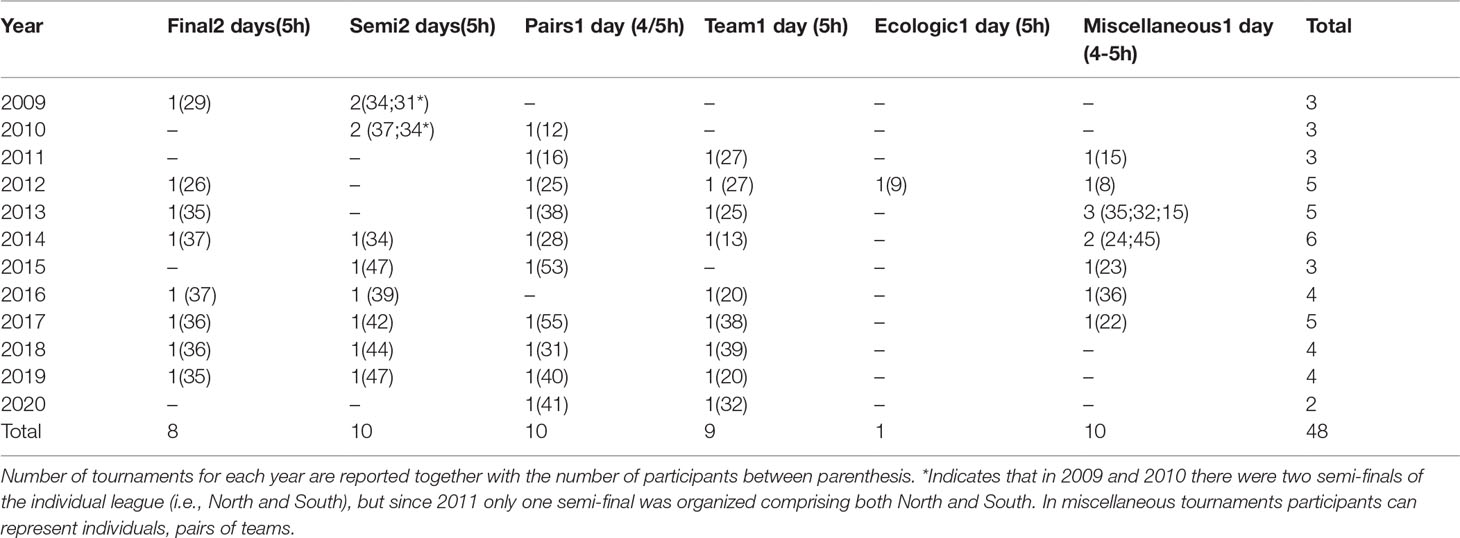
Table 2 A summary of the 48 tournaments analysed here from 2009 to 2020. Tournaments are organized according to their sections (e.g., final or semi-finals).
We characterize the social and economic aspects among participants to the Italian individual league. We first created and validated a questionnaire using a focus group interview with a small group of expert spearfishers, and then we distributed the survey to all the participants that participated to at least one final or semifinal tournament of the Italian individual league (N = 136). The focus group interview has been organized during the European dive show that took place in February 2019. The focus group was composed by 8 spearfishers who participated to the most recent individual league final. We discussed for at about 2 hours with spearfishers about the most important attitudes towards catching fish and motive statements for fishing. The focus group results have been integrated in a survey developed in Google form with 15 attitudinal statements and 17 motive statements adapted from Wilde, Riechers and Ditton (1998). Respondents were asked to indicate the level of agreement (5-point Likert-type scale; 1 = strongly disagree; 2 = disagree; 3 = neutral; 4 = agree; 5 = strongly agree). We also asked demographic questions such as age and, most importantly, respondents were also asked to indicate the costs (travelling, accommodation, boat and gear, food) associated to the last tournament they took part at.
We analysed the results of 48 tournaments organized in 29 different Italian localities from 2009 to 2020 (Figure 1). These tournaments included 73% (or 8 out of 11) of the finals and 71% (9 out of 11) of the annual semi-finals of the Italian individual spearfishing league, 91% (11 out of 12) of the league for pairs and 82% (9 out of 11)of the team’s league, and other tournaments such as the experimental ecological one held during those years (Table 2). We calculated the frequency and biomass of all the species caught during the tournaments and their trend across years. Subsequently, we calculated the catch per unit effort (CPUE; kg/spearfisher/h) according to the different spearfishing league sections (individual final, individual semi-finals, pairs, teams, ecological tournament, and miscellaneous ones) as well as typology (free movements with the boat or only by swimming). Moreover, we calculated the precision of spearfishers to catch specimens in accordance to tournaments-specific minimum weight limits for each species. We also indicated how many times participants finished the fishing day without catches and how many times they reached the daily bag limit for each species. Finally, we presented the frequency of agreement of spearfishers to the 32 statements presented through the survey, and calculated their economic expenditure for participating to tournaments.
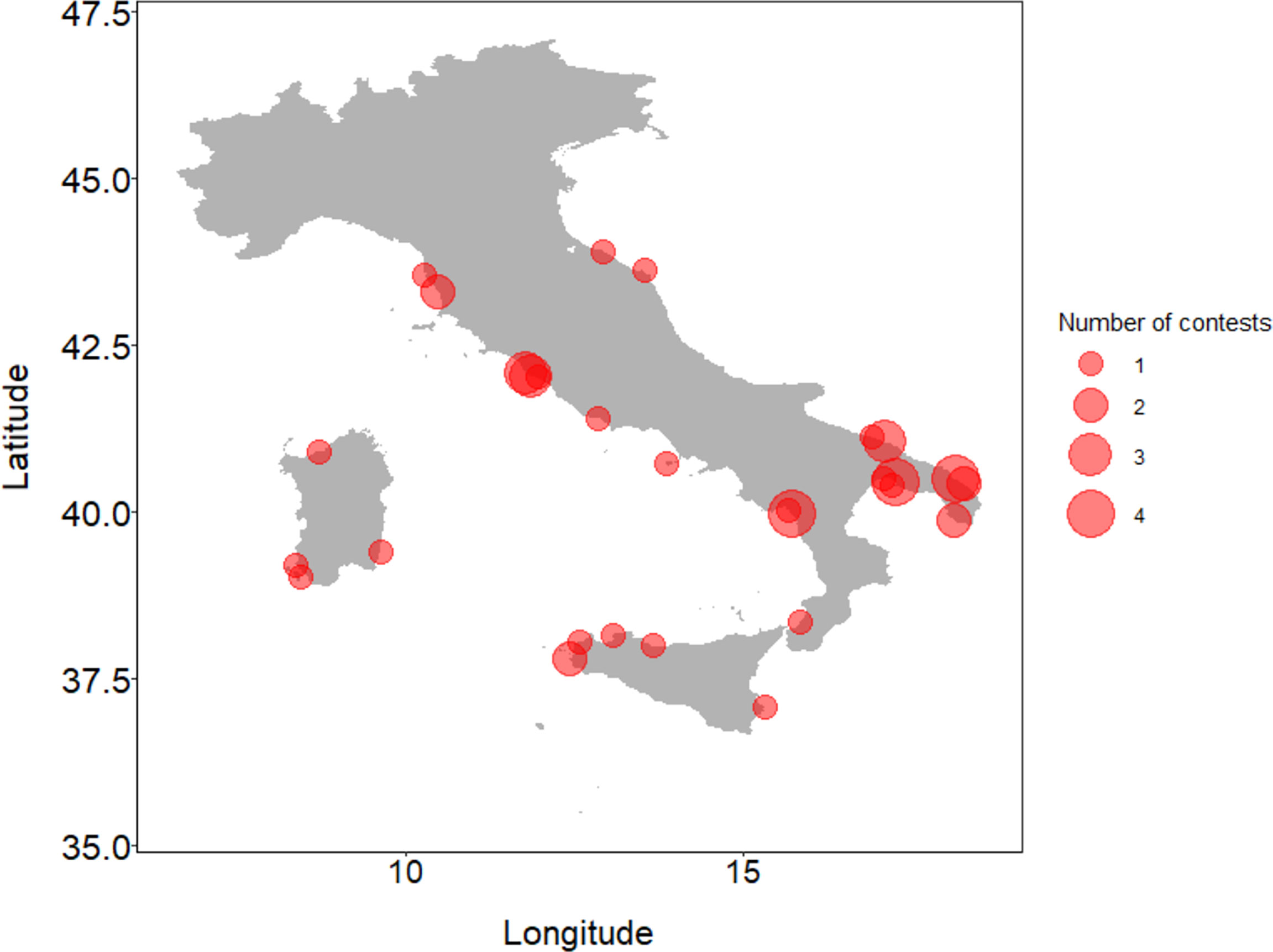
Figure 1 Geographical distribution of the marine spearfishing tournaments analysed in this study (N = 48).
We investigated temporal trends in catches by computing the non-parametric Kendall’s coefficient of concordance between response variables and years. We analysed CPUE as a semicontinuous variable by first using a generalized linear model with a binomial distribution with “probit” link to model binary transformed data (i.e., probability to catch something or not; Boulton and Williford, 2018). Then CPUE different from zero was transformed, by finding the exponent (lambda), which made the values of the response variable as normally distributed as possible with a power transformation, and modelled with liner models. In both cases (binomial and linear models), we used type (6 levels: individual final, individual semi-finals, pairs, teams, ecological tournament, and miscellaneous ones) and typology (2 levels: free movements with the boat or only by swimming) of tournaments as fixed factors in the models. Model fitting was examined by checking normality of residuals and plotting theoretical quantiles vs. standardized residuals. In all the cases we used a 95% confidence interval. All the analyses were performed using R (https://www.r-project.org/; version 3.5.0).
We retrieved the catches of a total of 834 individual participants, 339 pairs and 331 teams throughout the time period (2009-2020; Table 2). There were 282 cases in which no catches occurred during the daily round of the tournament (171 cases in individual tournaments, 80 cases in pairs tournaments, and 32 cases in team tournaments). We retrieved 8843 specimens caught by spearfishers (6475 specimens in individual tournaments, 1088 specimens in pairs tournaments, and 1567 in team tournaments), which accounted for 33 species – or group of species such as mugilidae – and a total biomass of 5665 kg (mean individual mass ± standard error; 0.64 ± 0.01 kg).
The five most caught species in terms of frequency were the white seabream (Diplodus sargus; 48% of catches), the brown wrasse (Labrus merula; 12%), the brown meagre (Sciaena umbra; 9%), the green wrasse (Labrus viridis; 5%), and the salema (Sarpa salpa; 4%), while the remaining 22% of catches was composed by additional 28 species or group of species (Figure 2). Regarding the total biomass, the five most caught species were the white seabream (Diplodus sargus; 2184 kg), the Mediterranean moray (Muraena helena; 787 kg), the brown meagre (Sciaena umbra; 549 kg), the brown wrasse (Labrus merula; 490 kg), and the European conger (Conger; 319 kg), while the remaining 1335 kg of catches were distributed across additional 28 species or group of species (Figure 3). The temporal trend of catches – regarding the five most caught species both in term of frequency (inlet in Figure 2) and biomass (inlet in Figure 3) – showed inter annual changes with some interesting temporal trends. Specifically, D. sargus showed a decreasing trend over years both in terms of proportion with respect to other species and total biomass, even if without statistical support (rτ = - 0.36; p = 0.09; inlet in Figure 2). Other species showed an increasing trend over years in terms of proportion of biomass such as M. helena, but again without statistical support (rτ = 0.42; p = 0.07; inlet in Figure 3). The size distribution of the most caught species also showed inter annual changes without significant increase or decrease of mean body mass of fishes caught across years (Figure 4).
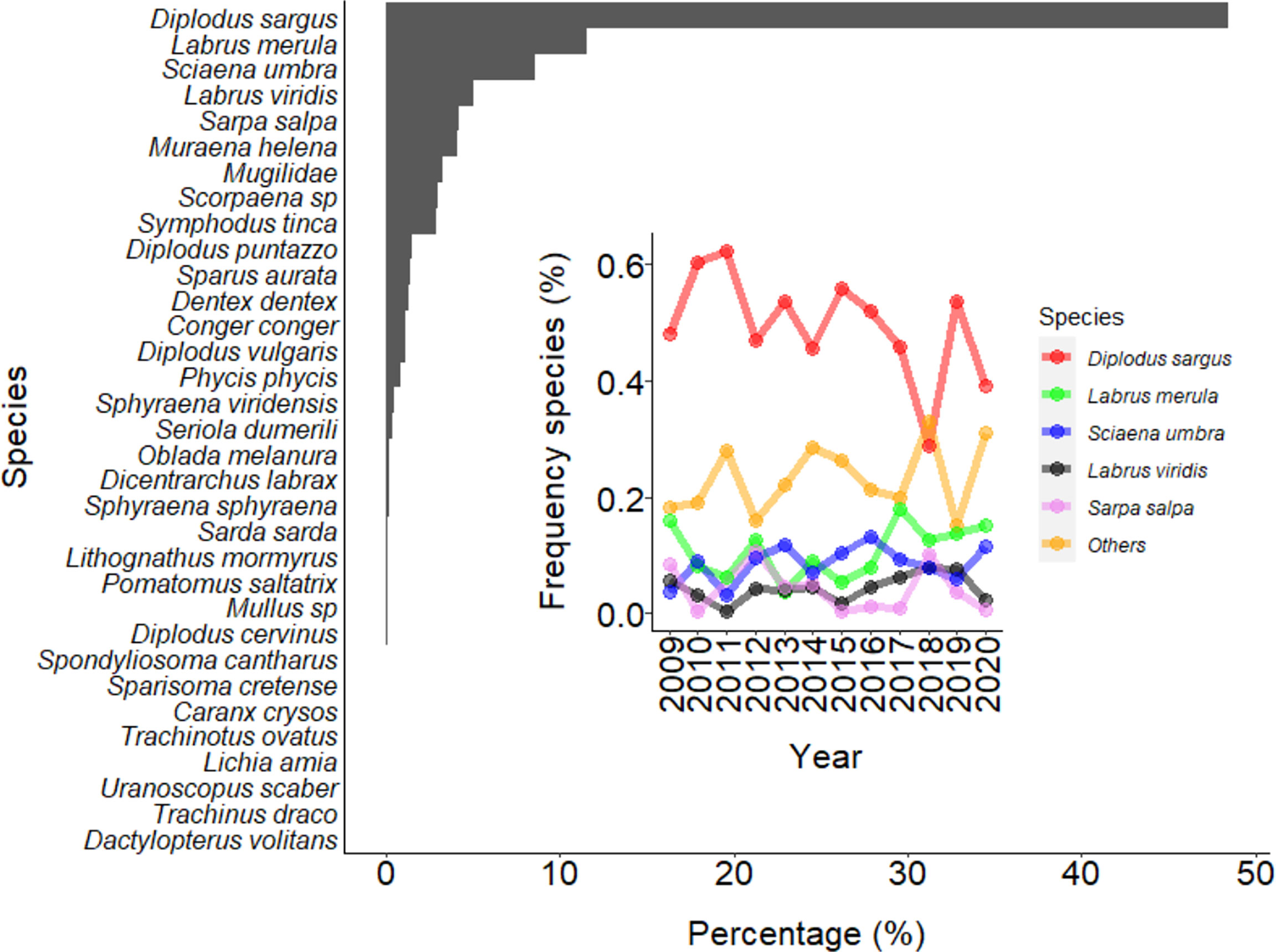
Figure 2 The frequency and temporal changes of species caught by spearfishers during Italian marine spearfishing tournaments from 2009 to 2020 (N total = 8843; N D. sargus = 4286; N L. merula = 1018; N S. umbra = 759; N L. viridis = 443; N S. salpa = 368; N others = 1969).
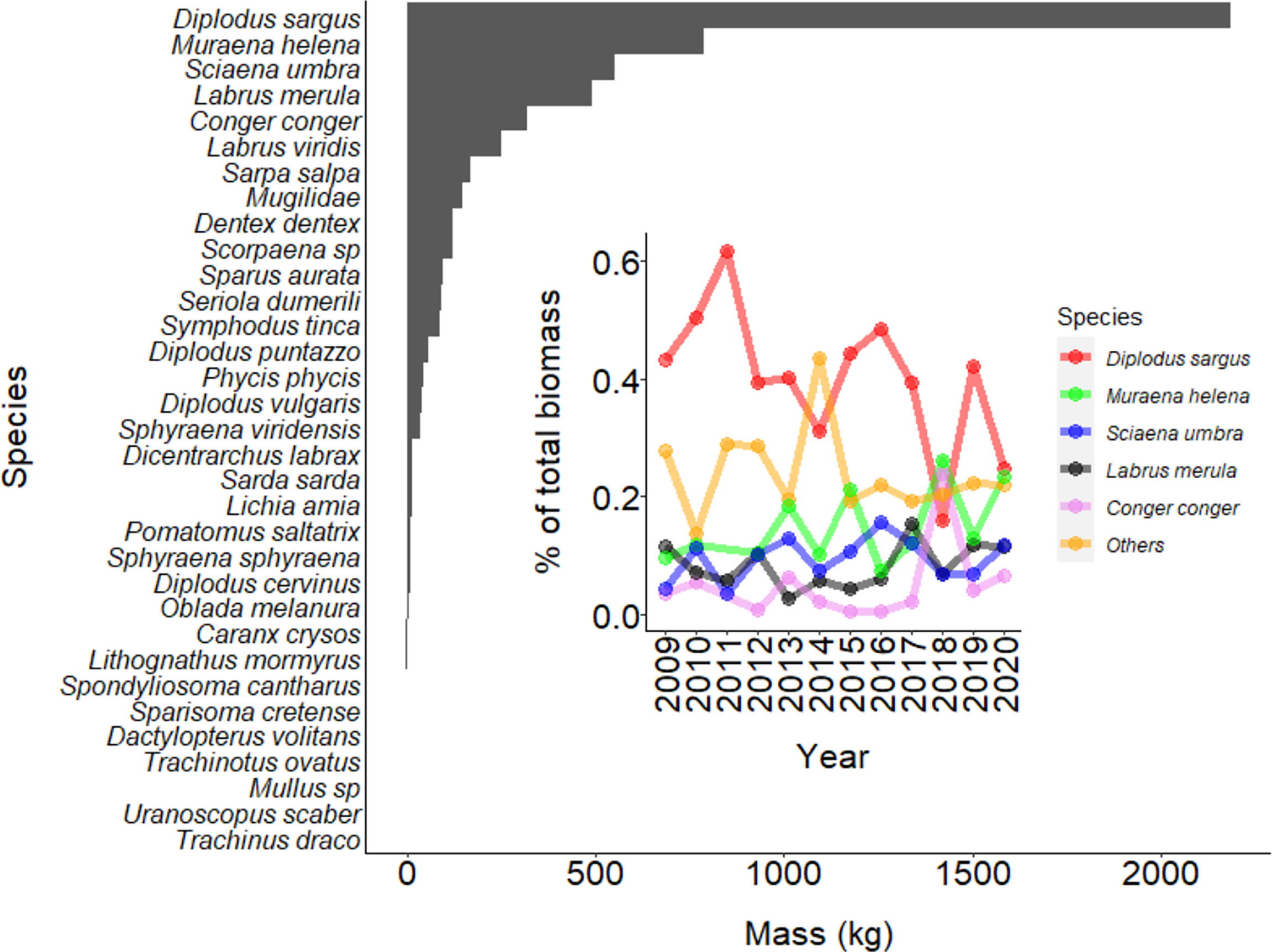
Figure 3 The total biomass and temporal changes of species caught by spearfishers during Italian marine spearfishing tournaments from 2009 to 2020 (N total = 8843; N D. sargus = 4286; N M. Helena = 362; N S. umbra = 759; N L. merula = 1018; N C. conger = 101; N others = 2317).
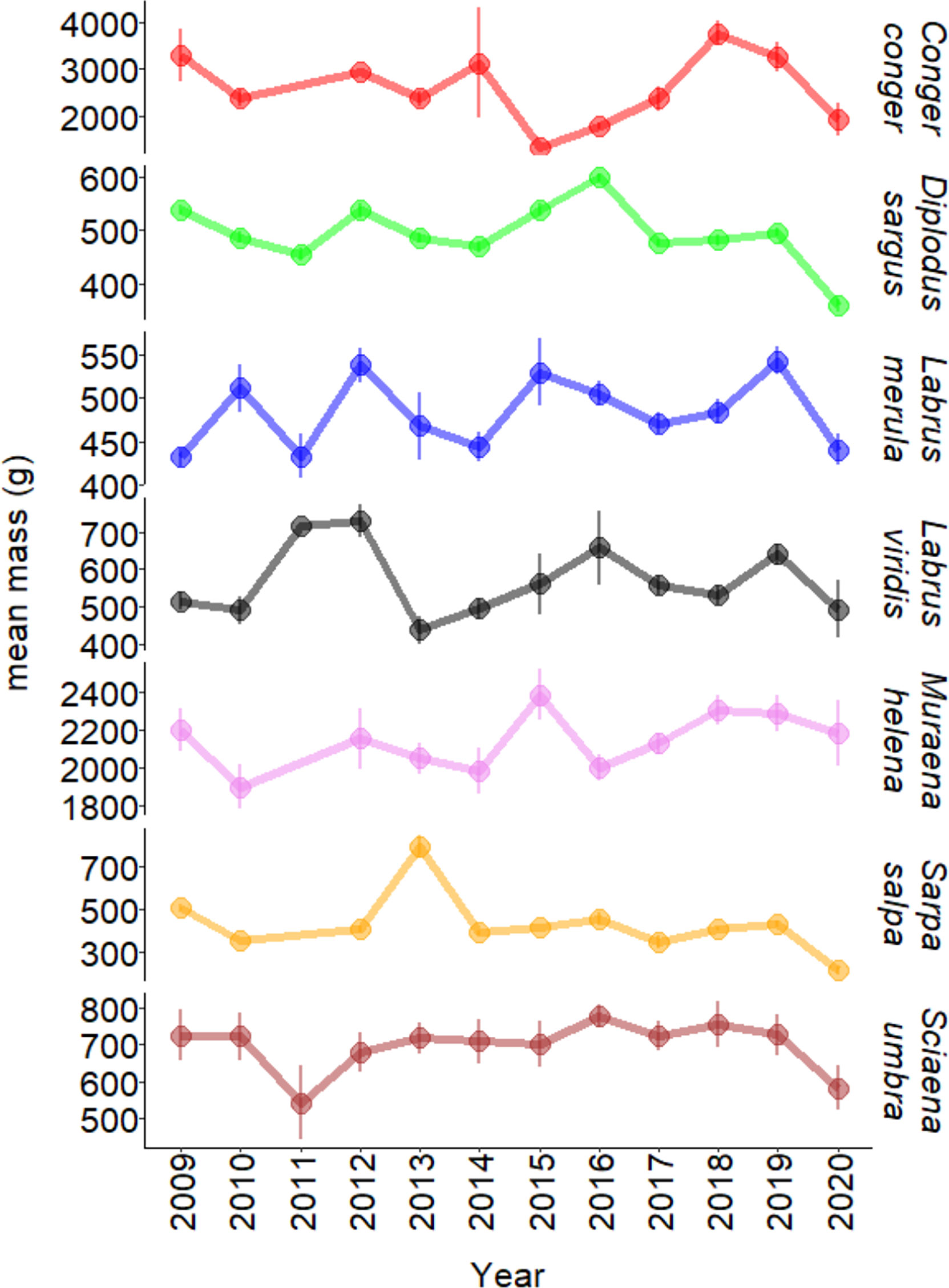
Figure 4 The temporal trends of the average size of individuals of the most representative species caught during Italian marine spearfishing tournaments from 2009 to 2020. Mean values are showed with points and vertical lines indicate the standard error (N C. conger = 101; N D. sargus = 4286; N L. merula = 1018; N L. viridis = 443; N M. Helena = 362; N S. salpa = 368; N S. umbra = 759).
The overall CPUE for all the tournaments was 0.47 ± 0.01 kg/spearfisher/h (mean ± standard error). Importantly, there were differences among type of tournaments as well as typology of displacement during the tournaments. We found that the highest chances to catch something were in the finals (Figure 5), while the lowest chances were in the pairs league and in other tournaments (Figure 5). Moreover, the chances of catching something during tournaments where participants were allowed to use a boat was significantly (Z = -6.37; p < 0.005) higher than during tournaments where participants were not allowed to use the boat (Figure 5). Similar results were obtained in the cases in which CPUE was different from zero where we found that the type of tournament has a significant effect on CPUE (F5,1799 = 159.4; p < 0.001). In particular, the CPUE recorded during the finals of the individual spearfishing league (0.86 ± 0.03 kg/spearfisher/h) was significantly (p < 0.01) higher than the ones recorded during the other tournaments (Figure 5). A similar pattern was found for the CPUE recorded during the semi-finals (p < 0.001; 0.60 ± 0.02 kg/spearfisher/h) with respect to the other tournaments with the exception of the experimental ecological tournament (0.26 ± 0.06 kg/spearfisher/h; Figure 5). Interestingly, we also found that the CPUE during the team league (0.29 ± 0.01 kg/spearfisher/h) was significantly (p < 0.001) higher than both the pairs league (0.21 ± 0.01 kg/spearfisher/h) and other tournaments (0.22 ± 0.02 kg/spearfisher/h; Figure 5). Finally, the CPUE during tournaments where participants were allowed to use a boat was significantly (p < 0.001) higher (0.68 ± 0.02 kg/spearfisher/h) than CPUE during tournaments where participants were not allowed to use the boat (0.37 ± 0.01 kg/spearfisher/h; Figure 5).
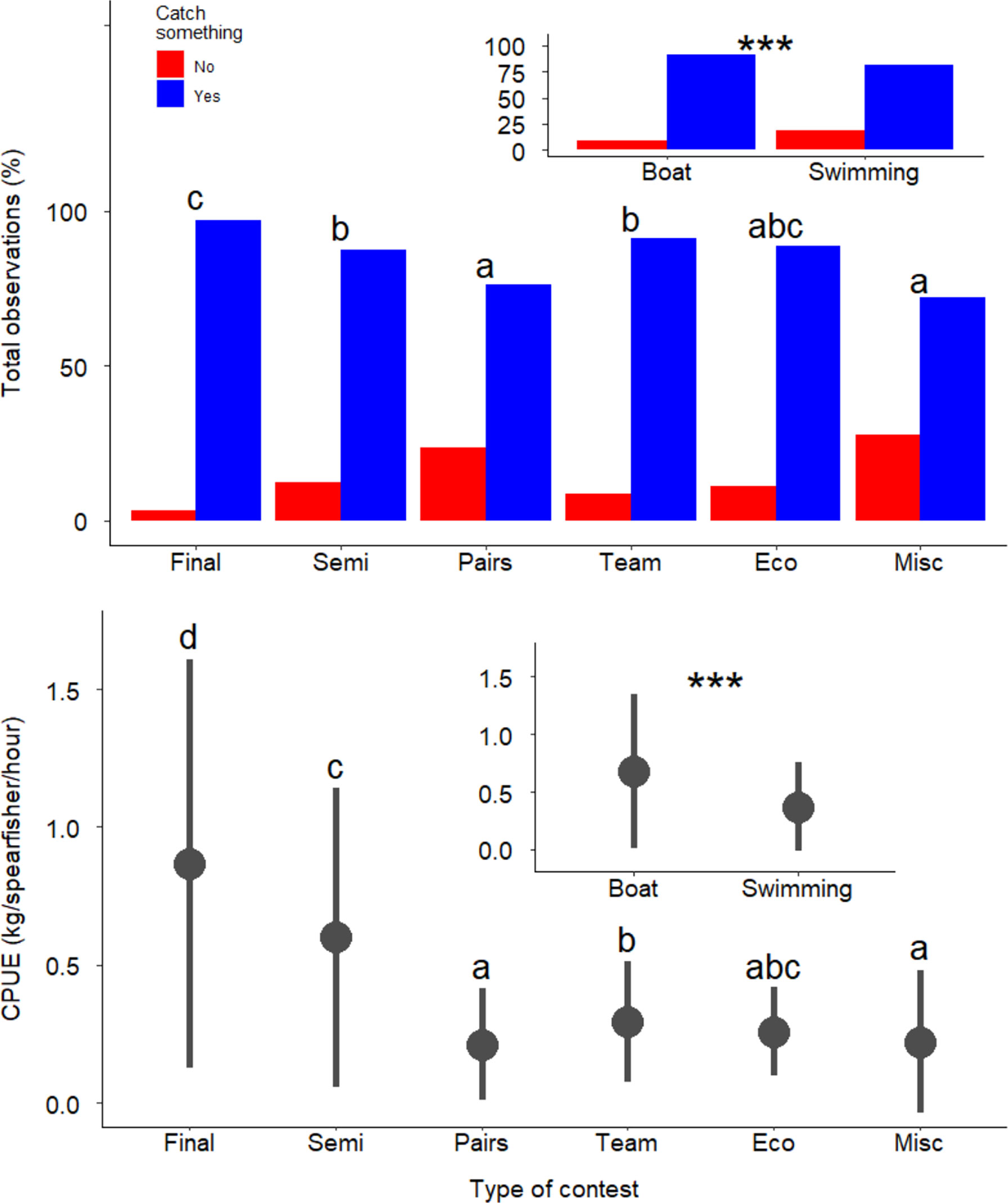
Figure 5 Catch per unit effort (kg/spearfisher/h) for each type of tournament and for each type of category (inlet) of Italian marine spearfishing tournaments from 2009 to 2020. Upper panel represent chances to catch something, while lower panel represents quantitative measures when at least one fish was caught. Points represent mean values and vertical lines represent the standard error. Letters in the main plot indicate the output of the Tukey post hoc test (a < b < c < d). *** in the inlet indicate significant differences with p < 0.001 (N Final = 533; N semi = 706; N Pairs = 339; N Teams = 241; N Eco = 9; N Misc = 254; N Boat = 1102; N Swimming = 980).
The precision of spearfishers to catch fish in accordance to tournaments-specific minimum weight limits was different according to the species (Figure 6). For example, the five most caught species in terms of frequency showed that spearfishers committed errors around 50 g below the weight limit, which in the tournaments considered here can be 300 or 400 g (Table 1) depending from the tournaments (mean ± standard error; D. sargus: 49 ± 1 g; L. merula: 53 ± 2 g; S. umbra: 47 ± 3 g; L. viridis: 59 ± 4 g; S. salpa: 54 ± 3 g; Figure 6). Interestingly, the highest errors were recorded for eel-like species (M. helena: 313 ± 20 g; C. conger: 263 ± 51 g; Figure 5) that have weight limit of 2000 g in all the tournaments presented here (Table 1). Furthermore, we recorded a total of 47 out of 1504 participants - including individuals, pairs and teams - that completed the daily bag limits for the following species or group of species: S. umbra (N = 25); D. sargus (N = 19); S. salpa (N = 2); Mugilidae (N = 1).
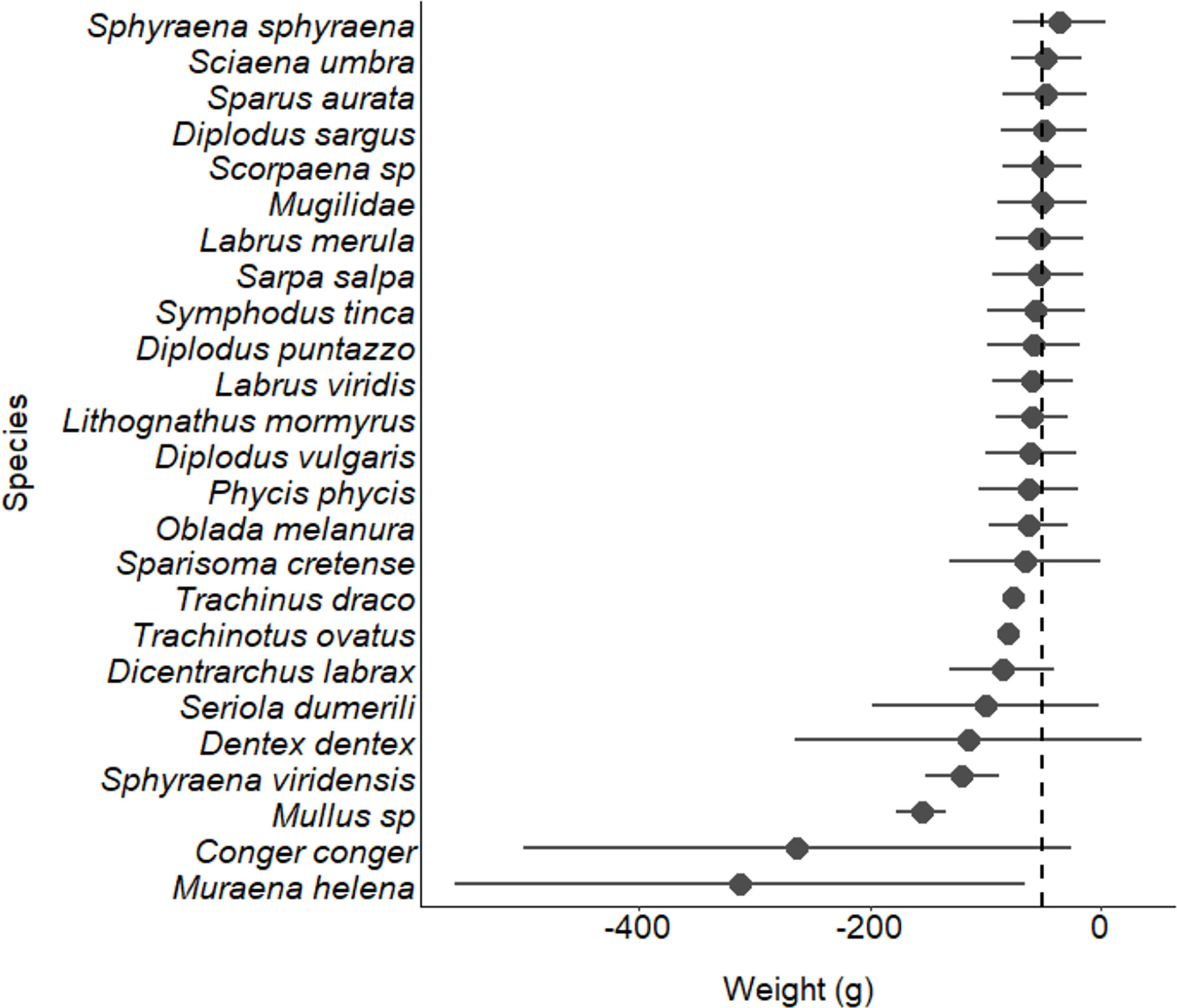
Figure 6 The precision of spearfishers is calculated as the difference between the weight of fishes and the tournaments-specific minimum weight limits. Points represent the mean values for each species and the horizontal lines represent the standard error. The vertical dashed line represents 50 g (N between 1113 for D. sargus and 1 for T. ovatus and T. draco).
Regarding the social aspects, we received replies from 75 out of 136 spearfishers contacted (55% response rate). Their age ranged from 23 to 65 years with a median equal to 41 years. Replies to attitudinal statements indicated that spearfishers participating to tournaments are big-fish oriented (i.e., they would rather catch one or two big fish than ten smaller fish), but not particularly catch oriented (i.e., they are just as happy if they do not shoot the fish they see and a fishing trip can be successful even if no fish are caught; Figure 7). Moreover, they do not usually give away the fish they catch because they usually eat it (Figure 7). Regarding the motives for fishing, spearfishers fish for experiencing adventure, excitement and new and different things as well as to be underwater (Figure 7). From an economic perspective, the total amount of money that participants spent to participate to the tournaments ranged from 800 to 3500 Euros (mean ± standard deviation; 1800 ± 591 euros). Moreover, the amount of days spent by participants to explore the areas of fishing before the tournaments were quite variable and ranged from 2 to 26 days with a median equal to 7 (expenditure per day equal to mean ± standard deviation; 277 ± 126 euros).
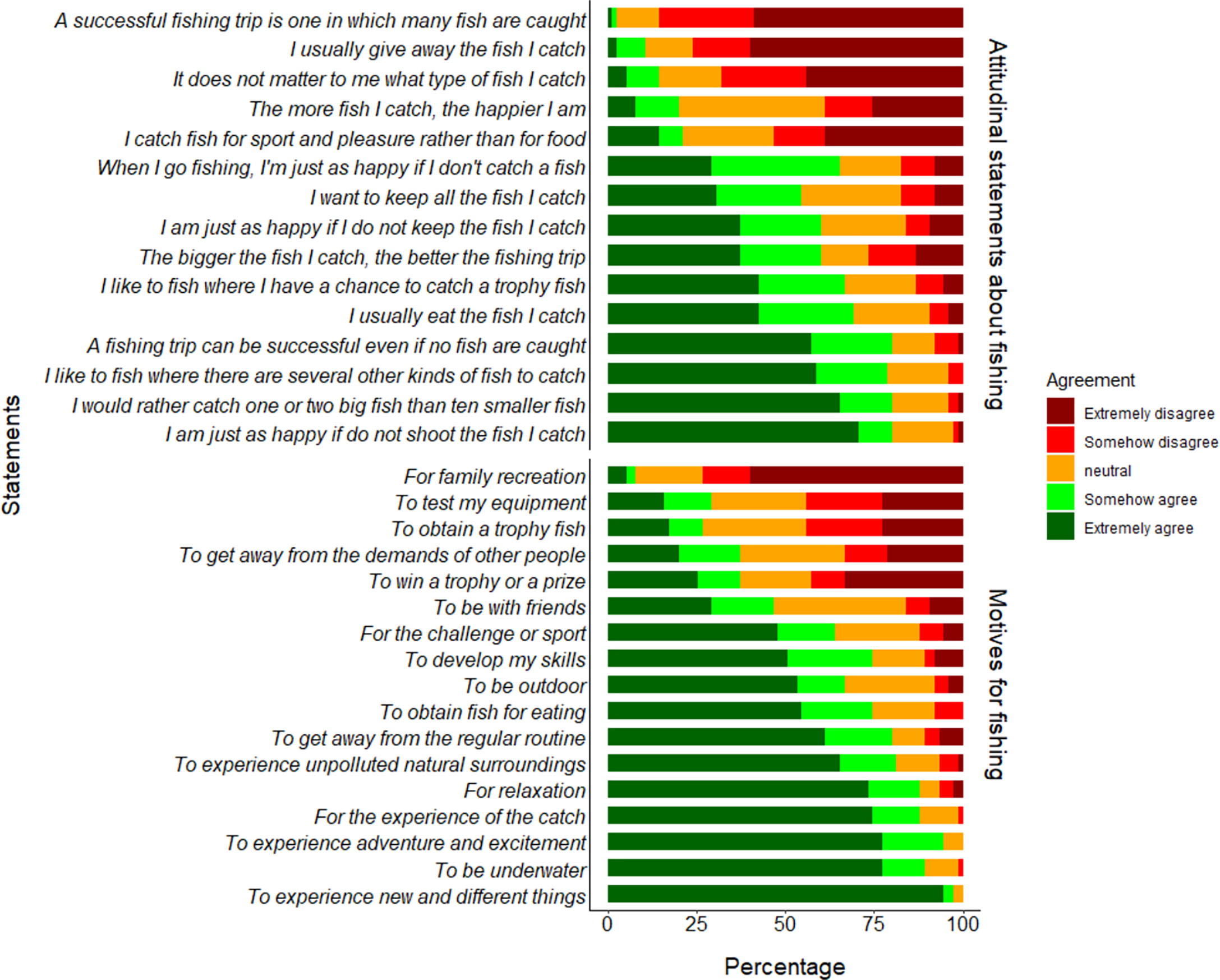
Figure 7 Attitudes towards catching fish and motive statements for fishing among Italian spearfishers that participated to at least one final or semifinal tournament of the national championship during the period 2017-2019. Percentage of replies according to a Likert scale is showed for each statement (N = 75).
This study provides a comprehensive, long-term and contemporary perspective of Italian marine spearfishing tournaments. There are four major results that are worthy to be specifically discussed. First, we showed that the species mostly target during Italian tournaments were not sensitive species in terms of risk of local extinction according to IUCN. Moreover, we did not find evident decreasing temporal trends in species-specific frequency, biomass, and average size. Second, we provided a quantitative and standardized measure of CPUE across different types of tournaments, suggesting the key role of spearfishers experience and skills and that using a boat can roughly double efficiency of spearfishing. Third, we assessed the accuracy of spearfishers in catching fish above a specific minimum size limit, which suggest spearfishers to be effective in respecting minimum size limits. Fourth, we characterized social and economic aspects that are important dimensions to be traded-off with potential biological and ecological impacts. All these aspects are below discussed in the context of spearfishing tournaments and, most importantly, in the general context of recreational spearfishing.
It has been long suggested that spearfishing tournaments can deplete local fish stocks and, above all, threaten endangered species (Smith et al., 1989; Coll et al., 2004). Our study showed that the most caught species in terms of frequency and biomass are also species targeted by recreational angling (Dedeu et al., 2019; Venturini et al., 2017), and small-scale fisheries (Battaglia et al., 2017). Moreover, these species are non-endangered according to the IUCN red list at the Mediterranean level: D. sargus (Least Concern); L. merula (Least Concern); S. umbra (Vulnerable); L. viridis (Vulnerable); S. salpa (Least concern); M. helena (Least concern); C. conger (Least concern). Vulnerable species such as S. umbra is already managed with a daily bag limit of 5 individuals with respect to a general bag limit of 10 individuals as for other species/taxonomic groups (e.g., Mugilidae, Scorpaena spp., etc). Providing an estimation of the impact of Italian spearfishing tournaments on local fish stocks is practically impossible because of the lack of a quantitative stock assessment for these species in the areas of study. The total biomass extracted in ten years, in the competitions examined here (5.7 tons) seems negligible with respect to that measured in recent studies. For example, Pranovi et al. (2016) estimated the total biomass extracted annually from all recreational fisheries along the Italian northern Adriatic Sea to be between 287 and 465 tons. Obviously this value represents all recreational fishing harvesting, but offers, anyway, a baseline for comparison. Another recent study carried out within the marine protected area of Portofino Marine Protected estimated that the biomass extracted by recreational anglers is about 8 tons per year (Venturini et al., 2017). It is worth noting that, despite the restrictive rules on recreational fishing within the marine protected areas of Portofino that exclude recreational spearfishing, the value obtained annually by Venturini et al. (2017) is higher than that obtained in more than 10 years in our study. Studies in other countries also supported this view. For example, Pita and Freire (2016) showed that the total biomass extracted from marine spearfishing tournaments in Galicia (Spain) was negligible compared to that of the commercial fleet (less than 1%). In summary, despite the total biomass extracted is not a robust indicator to assess the biological and ecological impact of spearfishing tournaments, it seems negligible with respect to other harvesting activities.The main target species identified in this study coincide with those found by other authors that analysed data from spearfishing tournaments in the Balearic Islands (Spain; Coll et al., 2004; Morales-Nin et al., 2005). However, we did not find significant decreasing temporal trend in frequency and biomass of species as well as their average size. This is in contrast to what has been showed by Coll et al. (2004), which showed frequency of Epinephelus marginatus decreasing from 1975 to 2001. It is important to remark that during the tournaments reported here, participants were not allowed to catch groupers (Epinephelus marginatus, E. costae, E. aeneus and Mycteroperca rubra). Importantly, as already pointed out by (Coll et al., 2004), the analysis of the catches during marine spearfishing tournaments only allows a descriptive analysis, which means that other factors could confound the temporal patterns. For example, the areas where spearfishing tournaments are organized could have strong differences in fish assemblages (e.g., some species could be more common than others), the meteorological conditions could affect the occurrence of species during the tournaments, the emergence of specific technological development could affect the efficiency of spearfishers, and above all, other recreational and professional fishing activities occur in the same areas and therefore could contribute to the exploitation of species. The interpretation of the results presented here and in previous studies in terms of temporal trends such as average size should be made with great caution. Interestingly, last year FIPSAS decided to reintroduce the catch of grouper per day in the national league, with the exception of E. marginatus. Monitoring the upcoming data collection will offer a unique opportunity for assessing the potential impact of spearfishing tournaments on groupers.Our results on CPUE provided a standardized quantification that can be also useful for application in the management of marine recreational spearfishing. The overall average CPUE (0.47 ± 0.01 kg/spearfisher/h) is the lowest of those recorded to date in marine spearfishing tournaments (Cinelli and Fresi, 1980; Smith et al., 1989; Coll et al., 2004; Morales-Nin et al., 2005; Pita and Freire, 2016). The first interesting comparison is with the study by Cinelli and Fresi (1980b) that showed a CPUE of 0.62 kg/spearfisher/h during Italian spearfishing tournaments from 1949 to 1977. It is important to note that the results of the former study represent spearfishing tournaments with SCUBA apparatuses, which is something not allowed anymore since 1980. Another aspect to point out is that local productivity and average size of fish could be lower in the Mediterranean Sea with respect to other areas, which could justify the higher values obtained in the Atlantic (1.60 kg/spearfisher/h; Pita and Freire, 2016) and Pacific (1.45 kg/spearfisher/h; Smith et al., 1989) oceans. Moreover, the study by Lincoln Smith et al. (1989) is referring to more than 30 years ago where the status of coastal fish stock was probably better than now. Finally, according to two studies from the Balearic Islands the CPUE of spearfishing tournaments from 1975 to 2001 was 1.50 kg/spearfisher/h (Coll et al., 2004), while it was 0.59 kg/spearfisher/h when considering spearfishing tournaments from 1998 to 2003 (average spearfishing time assumed to be 4h/day; Morales-Nin et al., 2005; Sbragaglia et al., 2021a). In summary, our study suggests that contemporary spearfishing tournaments have an overall CPUE that is decreasing with respect to previous studies. Future studies should focus in understanding what are the main factors driving such reduction of CPUE and whether longitudinal analysis of the performance of participants could reveal more insightful patterns.Our study demonstrated that CPUE of swimming spearfishers can be at about half of those using a boat. There are several factors that could account for this result. First, although swimming spearfishers are allowed to use global positioning systems (GPS) during the tournament they cannot move between most interesting points as quickly as with the boat limiting the possibility to increase chances of catching a fish. Second, swimming for the entire duration of the tournament could increase energy expenditure and therefore reduce the athletic performance in terms of time spent fishing underwater. Moreover, as expected the tournaments with a higher level of skilled spearfishers (i.e., finals and semifinals of the individual league) have the highest levels of CPUE. This agrees with previous studies showing a similar trend in Galicia (Spain; Pita and Freire, 2014). These results taken together provide interesting information that could contribute to better managing marine recreational fishing by controlling efficiency in terms of CPUE.The results related to the accuracy with respect to the minimum weight limit imposed during tournaments showed that spearfishing can be extremely selective in terms of body size especially of those species that are more frequently caught. This could represent a powerful tool for management because it offers the opportunity to control size-selectivity of spearfishers, at least in experts spearfishers or during tournaments. The comparison shown in Table 1 between the minimum dimensions imposed during competitions and the minimum dimensions adopted by the Italian national legislation, shows that the rules applied in spearfishing tournaments are much more restrictive than the national law. Spearfishing tournaments could be a testing ground for new conservation and management strategies, such as the use of harvest slots that protect smaller as well as larger fish (Ahrens et al., 2020). Indeed, size-selective harvesting can be particularly pronounced in spearfishing (Sbragaglia et al., 2021a), which could trigger changes individual behaviour that may consequently affect group behaviour, population dynamics and food-web functioning (Sbragaglia et al., 2021b). Such aspect is still overlooked and deserves further research attention together with possible direct effects of spearfishing tournaments on fish behaviour. For example, Sbragaglia et al. (2018) showed that many of the species caught by spearfishers in this study (e.g., D. sargus and S. salpa) decrease boldness – measured as flight initiation distance – in response to spearfishing. However, previous research seems to suggest no clear impacts of spearfishing tournaments on the density and abundance of coastal fish communities due to immigration of fish from nearby areas (Pita and Freire, 2014), which could be the case for individual changes in behaviour due to harvesting exclusively during spearfishing tournaments.The information obtained from the social and economic survey outlined the profile of the participants to marine spearfishing tournaments. We found that spearfishers do not evaluate the success of a fishing trip by the quantity of prey caught, but rather by the size of the individual catch. Moreover, they are oriented to catch a big fish and they care about what type of fish they catch. All together these results suggest that participants to spearfishing tournaments are specialized spearfishers. Moreover, we showed that among the 5 main motivations of spearfishers participating to tournaments there are non-catch related such as fishing for relaxation, for experiencing nature and enjoying new adventures and experiences, which agrees with general recreational fishing motivations (Knopf et al., 1973; Manfredo et al., 1996). Most importantly, recreational spearfishers participating to tournaments are motivated to fish by the simple reason to be underwater, which is a unique non-fishing motivations of spearfishing occurring especially in freediving (Young et al., 2016; Assis et al., 2018). Indeed, spearfishers’ connection with the water could be one of the reasons behind different social, psychological and physiological benefits provided by recreational spearfishing with respect to recreational angling (Sbragaglia et al., 2021a). Nevertheless, the experience of the catch plays an important role among spearfishers participating to tournaments and it would be interesting to compare such results with recreational spearfishers that do not participate to tournaments. Finally, spearfishers participating to tournaments are also food consumption-oriented, which agrees with previous results about recreational spearfishing in Portugal (Assis et al., 2018) and falls within the context of a recent review showing the importance of food in recreational fishing (Cooke et al., 2018). Importantly, food motivations could differ between recreational spearfishers and anglers because the use of lethal gear such as spearguns is linked to the deliberate choice to select the fish before harvesting it (Cooke et al., 2018). In summary, our study provides a baseline social-psychological profile for spearfishers participating to tournaments, which fills a gap of knowledge and could be instrumental to understand what differs in the motivations of different recreational spearfishers or with respect to anglers (Sbragaglia et al., 2021a).As regarding the economic expenditure, our results provide the first estimate of the expenditures associated to the Italian spearfishing’s contests. Our results suggest that the recreational spearfishing tournaments could substantially contribute to local economy the days of the tournaments as well as the weeks before during which participants scout the fishing grounds without fishing. Our economic expenditure estimates are a first attempt to quantify such contribution and future studies should consider more insightful methodological approaches such as travel-cost methods (Schilling et al., 2022), as well as consider the economic expenditure of all the directive staff involved in the organization of the tournaments. Nevertheless, our results are also supported by a recent study from Australia showing that economic contribution of spearfishing tournaments can contribute to local economy (Schilling et al., 2022). Such aspect should be considered at the moment to estimate the economic dimension of recreational fisheries (Hyder et al., 2018), and most importantly traded-off with social benefits and potential ecological impacts.
The raw data supporting the conclusions of this article will be made available by the authors, without undue reservation.
Ethical review and approval was not required for the animal study because Data were provided by the Italian Federation of Sport Fishing and Underwater Activities (FIPSAS) during national tournaments.
AT and VS conceived the study and coordinated the data collection. GT crossed checked the data and prepare them for analysis. VS and GT analysed the data. All the authors wrote the manuscript and gave final approval for publication. All authors contributed to the article and approved the submitted version.
Funds provided by Centro Ricerche ed Infrastrutture Avanzate in Calabria (CRIMAC), founded by FSC 2014-2020 - Piano Stralcio "Ricerca e Innovazione 2015 - 2017" - Programma Nazionale Infrastrutture di Ricerca (PNIR), linea d'azione 1. Cofinanziamento Infrastrutture di Ricerca (IR)
The reviewer ER declared a shared affiliation with the author AT to the handling editor at the time of review.
The remaining authors declare that the research was conducted in the absence of any commercial or financial relationships that could be construed as a potential conflict of interest.
All claims expressed in this article are solely those of the authors and do not necessarily represent those of their affiliated organizations, or those of the publisher, the editors and the reviewers. Any product that may be evaluated in this article, or claim that may be made by its manufacturer, is not guaranteed or endorsed by the publisher.
This work would not have been possible without the irreplaceable support of the FIPSAS technical stuff (judges and technical committee during the tournaments). Our biggest thanks go to them. VS is supported by a “Juan de la Cierva Incorporación” research fellowship (IJC2018-035389-I) granted by the Spanish Ministry of Science and Innovation. VS also acknowledges the Spanish government through the “Severo Ochoa Centre of Excellence” accreditation to ICM-CSIC (#CEX2019-000928-S). All reviewers made valuable contributions, providing important insights which greatly improved the final version of the manuscript.
Ahrens R. N. M., Allen M. S., Walters C., Arlinghaus R. (2020). Saving Large Fish Through Harvest Slots Outperforms the Classical Minimum-Length Limit When the Aim is to Achieve Multiple Harvest and Catch-Related Fisheries Objectives. Fish Fisheries 21, 483–510. doi: 10.1111/faf.12442
Arlinghaus R., Abbott J. K., Fenichel E. P., Carpenter S. R., Hunt L. M., Alós J., et al. (2019). Governing the Recreational Dimension of Global Fisheries. Proc. Natl. Acad. Sci. 116, 5209–5213. doi: 10.1073/pnas.1902796116
Assis J., Gonçalves J. M. S., Veiga P., Pita C. (2018). Spearfishing in Portugal: A Baseline Study on Spearfishers’ Profiles, Habits and Perceptions Towards Management Measures. Fisheries Manage. Ecol. 25, 417–428. doi: 10.1111/fme.12313
Battaglia P., Andaloro F., Consoli P., Pedà C., Raicevich S., Spagnolo M., et al. (2017). Baseline Data to Characterize and Manage the Small-Scale Fishery (SSF) of an Oncoming Marine Protected Area (Cape Milazzo, Italy) in the Western Mediterranean Sea. Ocean Coast. Manage. 148, 231–244. doi: 10.1016/j.ocecoaman.2017.08.014
Boada J., Sagué O., Gordoa A. (2017). Spearfishing Data Reveals the Littoral Fish Communities’ Association to Coastal Configuration. Estuarine Coast. Shelf Sci. 199, 152–160. doi: 10.1016/j.ecss.2017.10.007
Boulton A. J., Williford A. (2018). Analyzing Skewed Continuous Outcomes With Many Zeros: A Tutorial for Social Work and Youth Prevention Science Researchers. J. Soc. Soc. Work Res. 9 (4), 721–740. doi: 10.1086/701235
Brownscombe J. W., Hyder K., Potts W., Wilson K. L., Pope K. L., Danylchuk A. J., et al. (2019). The Future of Recreational Fisheries: Advances in Science, Monitoring, Management, and Practice. Fisheries Res. 211, 247–255. doi: 10.1016/j.fishres.2018.10.019
Cine F., Fresi E. (1980). Contributo Alla Valutazione Dell’effettiva Incidenza Della Pesca Subacquea Sul Patrimonio Biologico Delle Acque Costiere Italiane. Atti; Serie B: Memorie-Societa toscana di Sci. naturali, 330–339.
Coll J., Linde M., García-Rubies A., Riera F., Grau A. M. (2004). Spear Fishing in the Balearic Islands (West Central Mediterranean): Species Affected and Catch Evolution During the Period 1975–2001. Fisheries Res. 70, 97–111. doi: 10.1016/j.fishres.2004.05.004
Cooke S. J., Cowx I. G. (2004). The Role of Recreational Fishing in Global Fish Crises. AIBS Bull. 54, 857–859. doi: 10.1641/0006-3568(2004)054[0857:TRORFI]2.0.CO;2
Cooke S. J., Twardek W. M., Lennox R. J., Zolderdo A. J., Bower S. D., Gutowsky L. F., et al. (2018). The Nexus of Fun and Nutrition: Recreational Fishing is Also About Food. Fish fisheries 19 (2), 201–224. doi: 10.1111/faf.12246
Dedeu A. L, Boada J.,, Gordoa A., (2019). The First Estimates of Species Compositions of Spanish Marine Tecreational Fishing Reveal the Activity’s Inner and Geographical Variability. Fish Res, 216, 65–73.
Holder P. E., Jeanson A. L., Lennox R. J., Brownscombe J. W., Arlinghaus R., Danylchuk A. J., Cooke S. J. (2020). Preparing for a Changing Future in Recreational Fisheries: 100 Research Questions for Global Consideration Emerging from a Horizon Scan. Reviews Fish Biol. Fish. 30 1137–151
Hyder K., Maravelias C. D., Kraan M., Radford Z., Prellezo R. (2020). Marine Recreational Fisheries — Current State and Future Opportunities. ICES J. Mar. Sci. 77, 2171–2180. doi: 10.1093/icesjms/fsaa147
Hyder K., Weltersbach M. S., Armstrong M., Ferter K., Townhill B., Ahvonen A., et al. (2018). Recreational Sea Fishing in Europe in a Global Context-Participation Rates, Fishing Effort, Expenditure, and Implications for Monitoring and Assessment. Fish Fisheries 19, 225–243. doi: 10.1111/faf.12251
Knopf R.C. (1973). Recreational Needs and Behavior in Natural Settings. In: Altman, I., Wohlwill, J.F. (eds) Behavior and the Natural Environment. Human Behavior and Environment, vol 6. Springer, Boston, MA. doi: 10.1007/978-1-4613-3539-9_7
Lewin W. C., Weltersbach M. S., Ferter K., Hyder K., Mugerza E., Prellezo R., Strehlow H. V. (2019). Potential Environmental Impacts of Recreational Fishing on Marine Fish Stocks and Ecosystems. Fish. Sci. Aquacult. 27 (3), 287–330.
Manfredo M. J., Driver B. L., Tarrant M. A. (1996). Measuring Leisure Motivation: A Meta-Analysis of the Recreation Experience Preference Scales. J. leisure Res. 28 (3), 188–213. doi: 10.1080/00222216.1996.11949770
Morales-Nin B., Moranta J., García C., Tugores M. P., Grau A. M., Riera F., et al. (2005). The Recreational Fishery Off Majorca Island (Western Mediterranean): Some Implications for Coastal Resource Management. ICES J. Mar. Sci. 62, 727–739. doi: 10.1016/j.icesjms.2005.01.022
Pita P., Freire J. (2014). The Use of Spearfishing Competition Data in Fisheries Management: Evidence for a Hidden Near Collapse of a Coastal Fish Community of Galicia (NE Atlantic Ocean). Fisheries Manage. Ecol. 21, 454–469. doi: 10.1111/fme.12095
Pita P., Freire J. (2016). Assessing the Impact of Spear Fishing by Using Competitions Records and Underwater Visual Censuses. Scientia Marina 80, 27–38. doi: 10.3989/scimar.04352.15A
Pranovi F., Monti M. A., Caccin A., Colla S., Zucchetta M. (2016). Recreational Fishing on the West Coast of the Northern Adriatic Sea (Western Mediterranean) and its Possible Ecological Implications. Regional Stud. Mar. Sci. 3, 273–278. doi: 10.1016/j.rsma.2015.11.013
Sbragaglia V., Arlinghaus R. (2020). Conservation Bottom-Up Initiatives in Marine Recreational Spearfishing Suggest the Emergence of Positive Attitudes Towards Conservation. Scientia Marina84, 317–480. doi: 10.3989/scimar.05139.05A
Sbragaglia V., Arlinghaus R., Blumstein D. T., Coll M., Dedeu A. L., Diogo H., et al. (2021a). Spearing Into the Future: A Global Review of Marine Recreational Spearfishing. EcoEvoRxiv. doi: 10.32942/osf.io/f5whn
Sbragaglia V., Jolles J. W., Coll M., Arlinghaus R. (2021b). Fisheries-Induced Changes of Shoaling Behaviour: Mechanisms and Potential Consequences. Trends Ecol. Evol. 36, 885–888. doi: 10.1016/j.tree.2021.06.015
Sbragaglia V., Morroni L., Bramanti L., Weitzmann B., Arlinghaus R., Azzurro E. (2018). Spearfishing Modulates Flight Initiation Distance of Fishes: The Effects of Protection, Individual Size, and Bearing a Speargun. ICES J. Mar. Sci. 75, 1779–1789. doi: 10.1093/icesjms/fsy059
Sbragaglia V., Pla O. S., Gordoa A., Hernández S. P., Elias L. C., Pulido M., et al. (2016). The Barcelona Agreement: A Manifesto Towards the Spearfishing of the Future. Scientia Marina 80, 423–426. doi: 10.3989/scimar.04504.01A
Schilling H. T., Riley I. J., Puckeridge A. C., Milne-Muller A., Callaghan C. T. (2022). Economic Value of Regional Spearfishing Competitions. Fisheries Res. 250, 106289. doi: 10.1016/j.fishres.2022.106289
Smith M. L., Bell J., Pollard D., Russell B. (1989). Catch and Effort of Competition Spearfishermen in Southeastern Australia. Fisheries Res. 8, 45–61. doi: 10.1016/0165-7836(89)90040-4
Venturini S., Campodonico P., Cappanera V., Fanciulli G., Cattaneo Vietti R. (2017). Recreational Fisheries in Portofino Marine Protected Area, Italy: Some Implications for the Management. Fisheries Manage. Ecol. 24 (5), 382–391. doi: 10.1111/fme.12241
Wilde G. R., Riechers R. K., Ditton R. B. (1998). Differences in Attitudes, Fishing Motives, and Demographic Characteristics Between Tournament and Nontournament Black Bass Anglers in Texas. North Am. J. Fisheries Manage. 18, 422–431. doi: 10.1577/1548-8675(1998)018<0422:DIAFMA>2.0.CO;2
World Bank (2012). Hidden Harvest: The Global Contribution of Capture Fisheries (Washington, DC: Worldbank). Available at: https://openknowledge.worldbank.org/handle/10986/11873. License: CC BY 3.0 IGO.
Keywords: recreational fishing, spearfishing tournaments, long term monitoring, fishing management, policy actions
Citation: Terlizzi A, Tarantino G and Sbragaglia V (2022) Ecological, Social and Economic Aspects of Italian Marine Spearfishing Tournaments (2009-2020). Front. Mar. Sci. 9:891246. doi: 10.3389/fmars.2022.891246
Received: 07 March 2022; Accepted: 10 June 2022;
Published: 13 July 2022.
Edited by:
Cataldo Pierri, University of Bari Aldo Moro, ItalyReviewed by:
Fabio Fiorentino, Institute for Biological Resources and Marine Biotechnology, National Research Council (CNR), ItalyCopyright © 2022 Terlizzi, Tarantino and Sbragaglia. This is an open-access article distributed under the terms of the Creative Commons Attribution License (CC BY). The use, distribution or reproduction in other forums is permitted, provided the original author(s) and the copyright owner(s) are credited and that the original publication in this journal is cited, in accordance with accepted academic practice. No use, distribution or reproduction is permitted which does not comply with these terms.
*Correspondence: Antonio Terlizzi, YW50b25pby50ZXJsaXp6aUBzem4uaXQ=; Valerio Sbragaglia, dmFsZXJpb3NicmFAZ21haWwuY29t
Disclaimer: All claims expressed in this article are solely those of the authors and do not necessarily represent those of their affiliated organizations, or those of the publisher, the editors and the reviewers. Any product that may be evaluated in this article or claim that may be made by its manufacturer is not guaranteed or endorsed by the publisher.
Research integrity at Frontiers

Learn more about the work of our research integrity team to safeguard the quality of each article we publish.